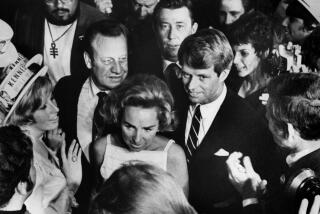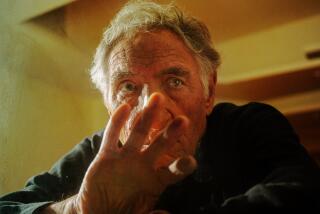Past Perfect
- Share via
WASHINGTON — One morning in the spring of 1954, as photographer Orlando Suero rode the bus down Fifth Avenue in New York on his way to work, he noticed a brief item in the paper about Sen. John F. Kennedy’s graceful young bride, Jacqueline, who was described as a political hostess, housewife and student of American history at Georgetown University. Hmmm, Suero noted to himself. That might be a great peg for a magazine story, and soon enough he was on his way to Washington to shoot a photo spread for McCall’s.
The poetry of a public life is often most evident in the before and after of fame: before society becomes obsessed with someone, and then again after the beast of celebrity has sated itself and slouched relentlessly onward. In the before and after, there is a cleaner shot at capturing the essence of a human being rather than the reflection of a myth. In the story of Jack and Jackie there was no after, and never will be, but there was a before, and we can see a poignant evocation of that in the pictures of Orlando Suero.
Of course, the title of a new book displaying these rarely seen old photographs, “Camelot at Dawn,” should be warning enough that separating the Kennedys from myth is no easy task. The poses struck by the handsome young couple offer further notice: Here, page after page, are early variations of many of the motifs of the mythologizing that would follow (football, books, art, friends, family), with some obvious political forethought in the posing. Still, there is something naturally sweet about these pictures.
The Kennedys had been married only a few months and were living in their first home together, a rented townhouse in Georgetown. Suero arrived there on May 5, 1954, with an assignment that was changing before his eyes. His original concept--to record the daily life of the young political wife--was quickly overtaken by the fact that the husband did not want to be left out of the action. After inserting himself into the story (“He was very media wise,” Suero recalled recently), Kennedy had only one further request: that he not be asked to do anything that would embarrass him or his office. In the end, Jackie proved to be the more cautious of the two, refusing to go along when some of her schoolmates bought Popsicles because she feared a rendering of the scene would appear unbecoming.
In considering the pictures Suero took during his five days with the Kennedys--Jack and Jackie peering down from their balcony to chat with old pal Lem Billings, lazing around the living room looking at their wedding photos, Jackie floating down the stairs on the way to a dance, blossoming with a flower, glowing with a candle, the two of them striding together in the shadows of the U.S. Capitol, idling away a glorious weekend morning reading the paper and oil-painting and gardening out back--it is tempting to think that here were moments of innocence in an age of innocence. This is in part because they look so slender and tender and young (she was 24, he 36), in part because we know so well the rest of the story, the coming fame and tragedy. Innocence beheld and innocence lost--it is at once true and false, the oldest deception in the human story.
Was it not wonderful that they spent so much time together? Yet Jackie was already chafing about how politics was taking her husband away so much. Who could look more elegant and radiant? Yet she thought she looked like a “monster” (except in Suero’s rapturous frames). Did Jack not seem the picture of fitness and vigor in his classic quarterback pose? Yet his back was killing him, and within months he would be on the operating table, near death. Who could appear more at ease and nonchalant? Yet the fire to become president burned inside. “He dragged me to Harry Truman’s birthday party” that week, Suero remembered. “He wasn’t inviting me as a buddy. He wanted to be photographed in that atmosphere.”
The Kennedys felt comfortable around Suero and were flattered by his pictures, and several times in the months after his May visit sent him letters encouraging him to come back for more. But he considered himself a news photographer, so he never returned. But that single long-ago assignment stayed with him for the rest of his career.
More to Read
Sign up for our Book Club newsletter
Get the latest news, events and more from the Los Angeles Times Book Club, and help us get L.A. reading and talking.
You may occasionally receive promotional content from the Los Angeles Times.








